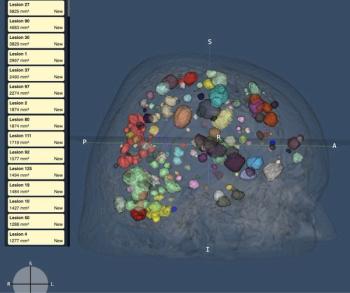
Multispecialty partnerships adopt ablation therapies
As more medical practitioners accept RFA and other tumor ablation methods for cancer treatment, physicians must determine how to integrate the procedure into their practices. The leap from academia to a clinical setting may be perilous, as tumor ablation doesn’t fit neatly into any one specialty. Does RFA belong in the interventional radiology box, the surgery box, or the oncology box?
As more medical practitioners accept RFA and other tumor ablation methods for cancer treatment, physicians must determine how to integrate the procedure into their practices. The leap from academia to a clinical setting may be perilous, as tumor ablation doesn't fit neatly into any one specialty. Does RFA belong in the interventional radiology box, the surgery box, or the oncology box?
Many practitioners are choosing to check "all of the above." That's because no one specialty has a lock on all the skills necessary to best treat patients. Tumor ablation demands excellent imaging skills - the domain of interventional radiologists - but also an oncologist's understanding of the progression of the disease and a surgeon's ability to handle complications. The best way to deal with these multiple needs, some clinicians are finding, is to bring the specialties together.
At the Sutter Cancer Center in Sacramento, CA, for example, thoracic and oncologic surgeon Gregory Graves and interventional radiologist Scott Foster have built a joint practice that uses both their strengths. By combining their skill sets, the two physicians are able to provide better treatment options to their patients.
"My training is in cancer surgery, so I can look at cases in terms of does this particular treatment option fit with their overall care, does it make sense, does it provide the best care available at this particular time for this patient with this problem," Graves said. "Having the clinical background to integrate when to use this technique or not allows us to carefully select the patients who are going to benefit most from this type of treatment option."
Graves and Foster jointly review the CT scans or other imaging studies and then decide whether a tumor is approachable, whether the procedure is feasible, and, finally, whether it's the best treatment option.
"That's what we're very concerned about - making sure that it is the right treatment at the right time for the right reasons for a given patient," Graves said.
For most patients, the correct treatment should be surgical resection, said Dr. Edgar Staren, a clinical surgical oncologist who formerly served as chairman of surgery at the Medical College of Ohio. Staren is now the senior vice president for clinical affairs at the Cancer Treatment Centers of America. Resection is still the gold standard for cancer treatment, he said, but circumstances can change. And that's where a joint practice with surgeons and interventional radiologists skilled in tumor ablation can be successful.
For example, intraoperative ultrasound may identify lesions in the liver that were not found by preoperative techniques. In such cases, the planned intervention can change between 30% and 50% of the time, and treatment with RFA may become the most appropriate option, Staren said.
But while most patients who are scheduled to undergo tumor ablation have already been identified as ineligible for resection, surgeons can still be vital to the process in case of complications from the procedure. At Sutter, surgeons are involved throughout the tumor ablation process to ensure a proper standard of care.
"It's much smoother," Graves said. "If you have the support of your surgical colleagues at the outset, they're on board and supportive and are willing to help deal with any complications that may arise."
Other specialists who can bolster a tumor ablation practice include radiologists, who can perform fusion imaging both before and after the procedure. Using both PET and CT before a procedure may reveal otherwise unrecognized disease, Staren said. A medical oncologist in the practice can recommend alternative or additional treatments in such cases.
"The majority of patients we treat with RFA will still have additional metastatic disease that's not being identified and not being treated," he said. "By giving them additional chemotherapy via systemic or an intra-arterial catheter to the liver, you're going to increase your ability to treat your patient. Not having an oncologist around is probably a mistake."
Finally, both Graves and Staren recommend directly working with or forming an informal relationship with lung, liver, or kidney specialists, for their expertise and their help in creating and sustaining a tumor-ablation practice. Graves' thoracic practice fostered the tumor-ablation program by providing referrals.
"I had large numbers of lung patients who were not candidates for an open lung procedure or a thorascopic lung procedure," Graves said. "We could offer this to them as an alternative. I think it eases the initial development of your program."
Similarly, Graves and Foster have established a good relationship with medical oncologists, although the process was not always easy.
"A number of them were very skeptical when we started this because there was no long-term data," Graves said. "Over time, when they referred patients who really had no other options, and they've done better than they ever would have anticipated, they have become supporters of it in very select patient groups."
Newsletter
Stay at the forefront of radiology with the Diagnostic Imaging newsletter, delivering the latest news, clinical insights, and imaging advancements for today’s radiologists.




